13 巻, 6 号
選択された号の論文の16件中1~16を表示しています
- |<
- <
- 1
- >
- >|
Special Issue on Advanced Abrasive Process Technologies
-
原稿種別: Editorial
2019 年 13 巻 6 号 p. 721
発行日: 2019/11/05
公開日: 2019/11/08
PDF形式でダウンロード (133K) -
原稿種別: Paper
2019 年 13 巻 6 号 p. 722-727
発行日: 2019/11/05
公開日: 2019/11/08
PDF形式でダウンロード (1444K) -
原稿種別: Paper
2019 年 13 巻 6 号 p. 728-735
発行日: 2019/11/05
公開日: 2019/11/08
PDF形式でダウンロード (2428K) -
原稿種別: Technical Paper
2019 年 13 巻 6 号 p. 736-742
発行日: 2019/11/05
公開日: 2019/11/08
PDF形式でダウンロード (1670K) -
原稿種別: Paper
2019 年 13 巻 6 号 p. 743-748
発行日: 2019/11/05
公開日: 2019/11/08
PDF形式でダウンロード (1144K) -
原稿種別: Paper
2019 年 13 巻 6 号 p. 749-755
発行日: 2019/11/05
公開日: 2019/11/08
PDF形式でダウンロード (3231K) -
原稿種別: Paper
2019 年 13 巻 6 号 p. 756-764
発行日: 2019/11/05
公開日: 2019/11/08
PDF形式でダウンロード (7458K) -
原稿種別: Paper
2019 年 13 巻 6 号 p. 765-773
発行日: 2019/11/05
公開日: 2019/11/08
PDF形式でダウンロード (4172K)
Regular Papers
-
原稿種別: Paper
2019 年 13 巻 6 号 p. 775-779
発行日: 2019/11/05
公開日: 2019/11/08
PDF形式でダウンロード (1368K) -
原稿種別: Paper
2019 年 13 巻 6 号 p. 780-786
発行日: 2019/11/05
公開日: 2019/11/08
PDF形式でダウンロード (1226K) -
原稿種別: Paper
2019 年 13 巻 6 号 p. 787-795
発行日: 2019/11/05
公開日: 2019/11/08
PDF形式でダウンロード (318K) -
原稿種別: Paper
2019 年 13 巻 6 号 p. 796-802
発行日: 2019/11/05
公開日: 2019/11/08
PDF形式でダウンロード (1928K) -
原稿種別: Paper
2019 年 13 巻 6 号 p. 803-809
発行日: 2019/11/05
公開日: 2019/11/08
PDF形式でダウンロード (3025K) -
原稿種別: Paper
2019 年 13 巻 6 号 p. 810-816
発行日: 2019/11/05
公開日: 2019/11/08
PDF形式でダウンロード (2764K) -
原稿種別: Paper
2019 年 13 巻 6 号 p. 817-824
発行日: 2019/11/05
公開日: 2019/11/08
PDF形式でダウンロード (3006K) -
原稿種別: Paper
2019 年 13 巻 6 号 p. 825-833
発行日: 2019/11/05
公開日: 2019/11/08
PDF形式でダウンロード (2907K)
- |<
- <
- 1
- >
- >|
